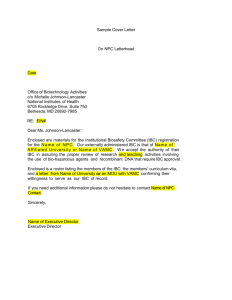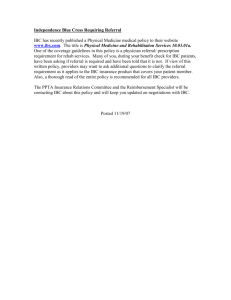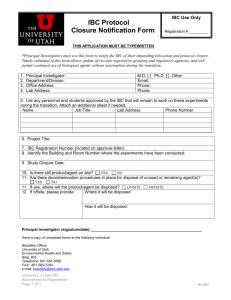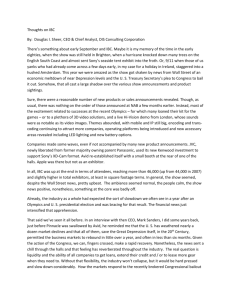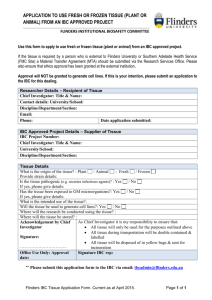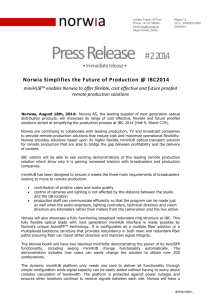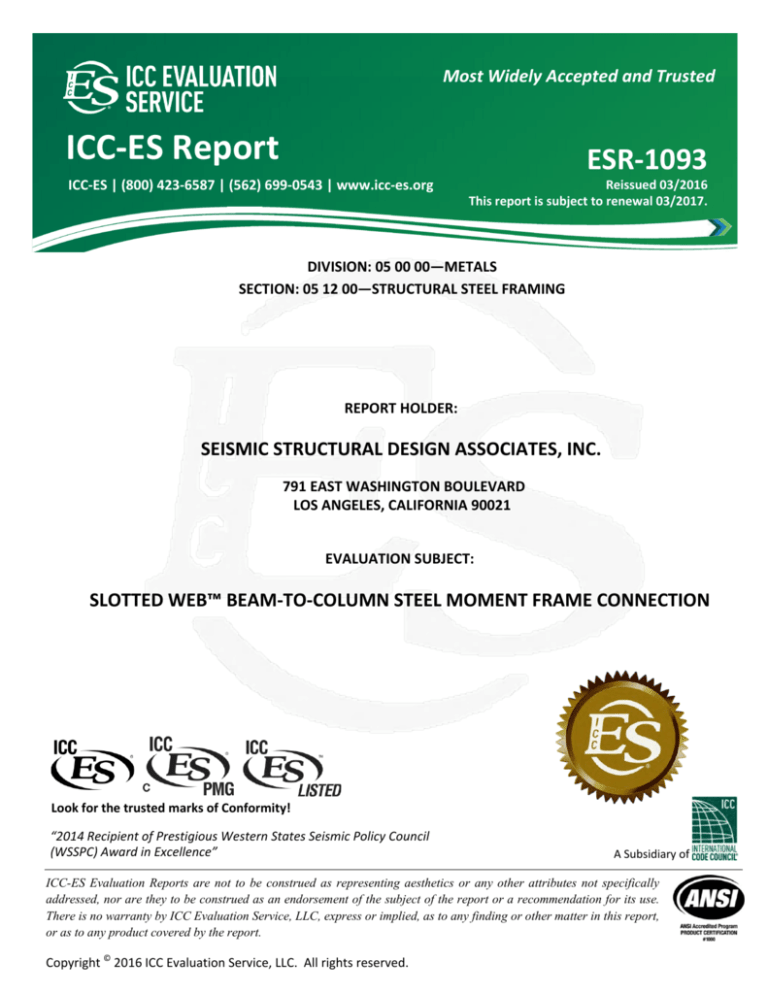
Most Widely Accepted and Trusted
0
ICC-ES Report
ICC-ES | (800) 423-6587 | (562) 699-0543 | www.icc-es.org
000
ESR-1093
Reissued 03/2016
This report is subject to renewal 03/2017.
DIVISION: 05 00 00—METALS
SECTION: 05 12 00—STRUCTURAL STEEL FRAMING
REPORT HOLDER:
SEISMIC STRUCTURAL DESIGN ASSOCIATES, INC.
791 EAST WASHINGTON BOULEVARD
LOS ANGELES, CALIFORNIA 90021
EVALUATION SUBJECT:
SLOTTED WEB™ BEAM-TO-COLUMN STEEL MOMENT FRAME CONNECTION
Look for the trusted marks of Conformity!
“2014 Recipient of Prestigious Western States Seismic Policy Council
(WSSPC) Award in Excellence”
A Subsidiary of
ICC-ES Evaluation Reports are not to be construed as representing aesthetics or any other attributes not specifically
addressed, nor are they to be construed as an endorsement of the subject of the report or a recommendation for its use.
There is no warranty by ICC Evaluation Service, LLC, express or implied, as to any finding or other matter in this report,
or as to any product covered by the report.
Copyright © 2016 ICC Evaluation Service, LLC. All rights reserved.
ICC-ES Evaluation Report
ESR-1093
Reissued March 2016
This report is subject to renewal March 2017.
www.icc-es.org | (800) 423-6587 | (562) 699-0543
DIVISION: 05 00 00—METALS
Section: 05 12 00—Structural Steel Framing
REPORT HOLDER:
SEISMIC STRUCTURAL DESIGN ASSOCIATES, INC.
791 EAST WASHINGTON BOULEVARD
LOS ANGELES, CALIFORNIA 90021
(213) 494-0446
www.slottedweb.com
EVALUATION SUBJECT:
SLOTTED WEB™ BEAM-TO-COLUMN STEEL MOMENT
FRAME CONNECTION
1.0 EVALUATION SCOPE
Compliance with the following codes:
2012 and 2009 International Building Code® (IBC)
Property evaluated:
Structural design
2.0 USES
The Seismic Structural Design Associates (SSDA) Slotted
Web™ Beam-to-Column Special Steel Moment Frame
(SMF) Connection (referred to hereafter as the SSDA
Slotted Web™ SMF connection) provides a beam-tocolumn connection in structural steel moment frames.
3.0 DESCRIPTION
3.1 General:
The SSDA Slotted Web™ SMF connection provides beamto-column moment resisting connections for use in steel
Special Moment Frame (SMF) systems. This proprietary
moment connection satisfies all applicable requirements of
the IBC and of ANSI/AISC 341-10, including Sections E3
and K1 for the 2012 IBC (ANSI/AISC 341-05, including
Section 9 and Appendix P for the 2009 IBC). The system
also meets the prequalification requirements of Sections
3.1 and 3.4 of the ICC-ES Acceptance Criteria for Steel
Moment Frame Connection Systems (AC129). The
connection system features wide flange (W-shape) steel
beams with two slots in the web, parallel and adjacent to
each flange. The beams are welded at the web and
flanges to flanges of wide flange (W-shape) steel columns
with complete-joint-penetration (CJP) groove welds. The
single shear plate is welded to the column flange with a
partial-joint-penetration or a CJP groove weld, as required
for strength, and to the beam web with a fillet weld.
A Subsidiary of the International Code Council ®
Continuity plates and doubler plates, as applicable in
accordance with Section 4.0, are provided at the column
flanges and web as illustrated in Figure 1.
3.2 Material:
3.2.1 Structural Steel Beams and Columns: Structural
steel for beams and columns must conformto ASTM A992
Grade 50 for beams, and ASTM A913 Grade 65 or ASTM
A992 Grade 50 for columns.
3.2.2 Plates: The steel plates must be fabricated from
structural steel complying with ASTM A572 Grade 50.
3.2.3 Welds: All CJP groove welds are designated as
demand critical welds, and must be made with a filler metal
complying with requirements of AWS D1.8: 2009, Clause
6.3, and capable of providing a minimum Charpy V-Notch
(CVN) toughness of 20 ft-lb (27 J) at -20°F (-29°C) as
determined by the AWS A5.20 classification test method,
and 40 ft-lb (54 J) at 70°F (21°C) as determined by Annex
A of AWS D1.8:2009 for the 2012 IBC (Appendix X of
AISC 341-05 for the 2009 IBC). Weld filler metal must be
E70-T6 H8 for welds at beam top and bottom flanges, and
E71-T8 H8 for other CJP groove welds and fillet welds.
Fillet welds must be made with a filler metal complying with
requirements of AWS D1.8: 2009, Clause 6, capable of
providing a minimum Charpy V-Notch (CVN) toughness of
20 ft-lb (27 J) at -20°F (-29°C) as determined by the AWS
A5.20 classification test method.
3.2.4 Bolts, Washers and Nuts: Bolts, washers and
nuts must conform to Section A 3.3 of AISC 360 and AISC
348. Bolts must comply with ASTM A325 or ASTM A490.
4.0 DESIGN AND INSTALLATION
4.1 Structural Design and Prequalification Limits:
The SSDA Slotted Web™ SMF connections are
prequalified for use in steel Special Moment Frames
(SMFs), within the limits noted in this report.
The axial loading in beams is not part of the connection
prequalification requirements, which is consistent with
AISC 341 and AISC 358. However, all steel moment
frame members and their connections must be designed to
resist all applicable load combinations prescribed in IBC
Section 1605, including those load combinations involving
axial tension and compression loading.
The structural design procedures must be in accordance
with Chapters 16 and 22 of the IBC as Load and
Resistance Factor Design (LRFD). Steel moment frames
using the SSDA Slotted Web™ SMF connection must be
designed using a capacity design approach as identified in
ICC-ES Evaluation Reports are not to be construed as representing aesthetics or any other attributes not specifically addressed, nor are they to be construed
as an endorsement of the subject of the report or a recommendation for its use. There is no warranty by ICC Evaluation Service, LLC, express or implied, as
to any finding or other matter in this report, or as to any product covered by the report.
1000
Copyright © 2016 ICC Evaluation Service, LLC. All rights reserved.
Page 1 of 8
ESR-1093 | Most Widely Accepted and Trusted
Page 2 of 8
Commentary to Section A3.2 of AISC 341-10 for the 2012
IBC (Section 6.2 of AISC 341-05 and its commentary for
the 2009 IBC). Strength demands at the critical sections
must be determined by calculation, applying statics that
consider the effects of the probable maximum bending
moment and corresponding shear at the plastic hinge
location. CJP groove welds must be used between beam
flanges and column flange, and between beam web and
column flange. The shear plate must be connected to the
column flange using either a PJP or CJP welds, depending
on the strength requirements, and connected to the
beam web with fillet welds as illustrated in Figure 1.
For determining seismic loads, the system seismic
performance coefficients and factors for the IBC are to be
as follows:
RESPONSE
SYSTEM
DEFLECTION
SEISMIC
MODIFICATION OVERSTRENGTH AMPLIFICATION
SYSTEM*
COEFFICIENT
FACTOR, Ω0
FACTOR, Cd
Special
Steel
Moment
Frames
8
1
3
5 /2
*Seismic force–resisting system as defined in ASCE 7-10 and
ASCE 7-05, Table 12.2-1.
In addition, compliance with the American Welding
Society (AWS) Structural Welding Code–Steel (ANSI/AWS
D1.1:2010 for the 2012 IBC and D1.1:2004 for the 2009
IBC), with modifications as set forth in AISC 360 Section
J2, and Section 3.2.3 of this report, is required. The design
must also take into account requirements set forth in
Sections 4.1.1 through 4.1.17 of this report.
4.1.1 Beam Slot Dimensions: The beam slots must
terminate at 11/16-inch-diameter (27 mm) holes for beams
24 inches (610 mm) deep and greater or 13/16-inchdiameter (21 mm) holes for beams less than 25 inches
(610 mm) deep. The beam slot length, ls, must meet the
least of the following equations (within ±10%):
ENGLISH UNITS
ls
=
=
=
=
1/2
102tf / (Fye)
d
2
lp + (lb-lp) / 10
=
=
=
=
4.1.2 Plastic Hinge Location: For calculation purposes,
, on the beam or
the web plastic hinge location,
girder, must be determined as follows:
lhinge = lb -lp
Zb -Zf / 3Zb
where:
lhinge
= Web plastic hinge length, measured from end of
shear plate toward beam center, inches (mm).
Zb
= Plastic section modulus of beam cross section,
in.3 (mm3).
Zf
= Plastic section modulus of beam flanges, in.3
(mm3).
Other terms are defined in Section 4.1.1 of this report.
The centroid of the beam plastic hinge region, that
consists of beam flanges from end of slots to column face,
the shear plate, and the beam web region from end of slots
to the column face, shall be taken at the end of the shear
plate.
4.1.3 Plastic Moment Capacity at Hinge(s): Plastic
moment capacity at the plastic hinge location, which does
not include the effects of strain hardening, must be
calculated as follows:
where:
Mp
= Plastic moment
(N-mm).
Zb
= as defined in Section 4.1.2 of this report.
Fye
= Ry Fy
capacity
at
hinge,
kip-in.
where:
SI UNITS
ls
1.5bf
Slot widths are 1/8 inch (3.2 mm) along the shear plate
and 1/4 inch (6.4 mm) for the remainder of the length, as
illustrated in Figure 1.
1.5bf
Ry
= ratio of the expected yield stress to the specified
minimum yield stress Fy.
Fy
= specified minimum yield stress of the type of
steel to be used in the yield element, ksi (MPa).
1/2
268tf / (Fye)
d
2
lp + (lb-lp) / 10
where:
4.1.4 Probable Maximum Moment at Hinge(s):
Probable maximum moment at the beam plastic hinge
location, which includes the effects of strain hardening,
must be calculated using the following equation:
bf
= Beam flange width, inches (mm).
d
= Beam depth, inches (mm).
Fye
= Expected yield strength of steel beams, ksi
(MPa).
where:
= Ry Fy
Mpr
= Probable maximum moment at hinge, kip-in.
(N-mm).
Cpr
= Factor to account for the peak connection
strength, including strain hardening effect, must
equal to 1.1.
Zb
= as defined in Section 4.1.2 of this report.
Fye
= as defined in Section 4.1.3 of this report.
ls
= Beam slot length, inches (mm).
tf
= Beam flange thickness, inches (mm).
lb
= One-half clear span (between column flanges)
length of beam, inches (mm).
lp
= Width (along the beam span direction) of shear
plate, inches (mm).
Ry
Fy
= Ratio of the expected yield stress to the
specified minimum yield stress, in accordance
with Table A3.1 of AISC 341-10 for the 2012
IBC (Table I-6-1 of AISC 341-05 for the 2009
IBC), ksi (MPa).
4.1.5 Moment at Colum Center Line(s): The moment
must be calculated as follows:
= Specified minimum yield stress of the type of the
steel to be used, ksi (MPa).
is the distance between the centroid of beam
plastic hinge and column center line.
∙
2
ESR-1093 | Most Widely Accepted and Trusted
Page 3 of 8
4.1.6 Adequacy of Connection Flexural Capacity: The
connection must develop the full ductile capacity (Mpr) of
the beam.
4.1.7 Required Shear Strength at Connection: The
required shear strength Vu of beam and beam web-tocolumn connection must be determined using the following
equation:
2Mpr
+Vgravity
Vu =
L'
where:
Vu
= required shear strength of beam and beam-tocolumn connection, kips (N).
L′
= distance between beam web plastic hinges,
inches (mm).
Mpr
= maximum probable moment at hinge, kip-in
(N-mm). See Section 4.1.4.
Vgravity = beam shear force resulting from the following
, as defined in
factors
1.2
Equation 16-5 of the IBC, kips (N).
In addition, the design shear strength of the beam must
be checked according to Chapter G of AISC 360,
.
4.1.8 Column Panel Zone: The column panel zone must
comply with Section E3.6e of AISC 341-10 and Section
J10.6(b) of AISC 360-10 for the 2012 IBC (Section 9.3b of
AISC 341-05 and Section J10.6(b) of AISC 360-05 for the
2009 IBC). The contribution of panel zone deformation to
overall story drift must be considered in accordance with
ASCE 7 Section 12.7.3.
4.1.9 Shear Plate Design: The width Ip is 4 to 6 inches
(102 to 152 mm). The height is determined as follows:
hp = T - 2 inches
SI: hp = T – 51 mm
where:
hp
= Required shear plate height, inches (mm).
T
= Distance between web toes of fillets at top and
bottom of the beam web, inches (mm).
The thickness, tp, must be determined using the following
equation:
6
= eccentricity of shear plate (in. or mm)
e
= Mweld /Vweld
Vbeam = Shear at face of column, kips (kN)
=
.
where:
tp
= as defined in Section 4.1.9 of this report.
Fye
= as defined in Section 4.1.3 of this report.
D
= Shear at column face resulting from unfactored
dead loads, kips (kN).
L
= Shear at column face resulting from unfactored
live loads, kips (kN).
S
= See Section 1605.2 of the IBC.
tw
= Thickness of beam web, inches (mm).
f1 & f2 = As defined in Equation (16-5) of the IBC.
Mp
= as defined in Section 4.1.3 of this report.
lb
= as defined in Section 4.1.1 of this report.
lp
= as defined in Section 4.1.1 of this report.
Zweb
= Plastic section modulus of beam web, in3 (m3).
2
= twT /4
where:
T
= as defined in Section 4.1.9 of this report.
4.1.11 Continuity Plate Requirements: Design of the
continuity plates is the responsibility of the registered
design professional and must meet the requirements of
Section E3.6f of AISC 341-10 for the 2012 IBC (Section
7.5 of AISC 341-05 and Section 2.4.4 of AISC 358-05s1-09
for the 2009 IBC).
4.1.12 Beam
Limitations:
In
accordance
with
requirements in AISC 341-10 for the 2012 IBC (AISC
341-05 for the 2009 IBC), beams must satisfy the following
limitations:
1. Beams must be rolled wide-flange shapes or built-up
sections prescribed in Section 2.3 of ANSI/AISC
358-10 including AISC 358s1-11. Material for plates
and welds for built-up beams must conform to Section
3.2 of this report.
2. Beam depth is limited to the maximum allowed for a
W36.
where:
tp
= Required shear plate thickness, inches (mm).
Zb
= Plastic section modulus of the beam, in.3 (mm3)
3
The thickness of the plate must be at least /8 inches
2
(10 mm) or at least /3 of the beam web thickness,
whichever is greater. For other terms, see Section 4.1.1 of
this report.
4.1.10 Shear Plate Welding Design: The shear plate
must be welded to the beam web with a C-shaped fillet
weld that has been designed to resist Mweld, Vweld, and the
resulting eccentricity, e. These values are determined
using the following equations:
Mweld = moment
(N-mm)
=
Vweld
e
1.1
resisted
by
shear
plate,
= shear resisted by shear plate, lbf (N)
=
/
lbf-in
3. Beam weight is limited to a maximum of 400 lbs/ft
(600 kg/m).
4. Beam flange width and thickness must comply with
Sections E3.5 and D1.1 of AISC 341-10 for the 2012
IBC (Section 9.4 of AISC 341-05 for the 2009 IBC).
Beam flange thickness is limited a maximum of
21/4 inches (57 mm).
5. Beams must be full length between Slotted Web™
Steel Moment Frame Connections.
6. The ratio of the distance between beam hinge
centerlines over the beam depth must be limited to 6.5
or greater.
7. Lateral bracing of beams must be provided as follows:
The beam must be braced in conformance with
Sections E3.5 and D1.2 of AISC 341-10 for the 2012
IBC (Section 9.8 of AISC 341-05 for the 2009 IBC),
where the length of the beam is defined as the distance
between the ends of the Slotted Web™ connections.
ESR-1093 | Most Widely Accepted and Trusted
Page 4 of 8
As tested, and in conformance with AISC 341, no
supplemental lateral bracing is required at or near the
plastic hinge.
resistance factor provisions, to gross area of the
column (psi or Pa).
∑
∗
∑
∗
4.1.13 Lateral Bracing Requirements: Lateral bracing
must comply with Sections E3.4b and E3.4c of AISC 34110 for the 2012 IBC (Sections 9.7 and 9.8 of AISC 341-05
for the 2009 IBC), except that no beam end lateral bracing
(at or near the plastic hinge) is required.
4.1.14 Panel Zone Deformation: The contribution of
panel zone deformations to overall story drift must be
determined so as to comply with ASCE 7, Section 12.7.3,
and AISC 360, Section J10.6.(b).
4.1.15 Column Limitations: Columns must satisfy the
following limitations:
1. Columns must be rolled wide-flange shapes or built-up
sections prescribed in Section 2.3 of AISC 358-10
including AISC 358s1-11. Materials for plates and
welds for built-up columns must conform to Section 3.2
of this report.
2. The column depth is limited to a maximum W36
(W920).
3. The column is limited to a maximum weight of 710 lb/ft
(1057 kg/m).
4. Column orientation: beam is connected to column
flange.
5. Width-thickness ratios for the flanges and web of
columns must conform to the limits of Sections E3.5a
and D1.1 of AISC 341-10 for the 2012 IBC (Section 9.4
of AISC 341-05 for the 2009 IBC).
6. Lateral bracing of the columns must be provided in
accordance with Section E3.4c of AISC 341-10 for the
2012 IBC (Section 9.7 of AISC 341-05 for the 2009
IBC).
4.1.16 Column-Beam Relationship Limitations:
1. The design shear strength of the column web must be
determined in accordance with Section E3.6e of AISC
341-10 and Section J10.6b of AISC 360-10 for the
2012 IBC (Section 9.3 of AISC 341-05 and Section
J10.6b of AISC 360-05 for the 2009 IBC).
2. Column-beam ratios must be limited as follows:
The column-beam ratio must be satisfied by applying Eq-2:
∑
∗
∑
∗
1.0
Eq-2)
where:
∑
∗
∑
∗
=
∑
The sum of the projections of the nominal
flexural strengths (Mpc) of the column above
and below the connection joint, at the
intersection of the beam and column
centerline with a reduction for the axial force
in the column. The nominal flexural strength
of the column may be computed in
accordance with Eq-3:
(Eq-3)
where:
Zc
= The plastic section modulus of the column
(in.3 or m3).
Fyc
= The minimum specified yield strength of the
column at the connection (psi or Pa).
Pu/Ag = Ratio of column axial compressive load,
computed in accordance with load and
= The sum of the projections of the expected
flexural strengths of the beams at the web
plastic hinge locations to the column centerline.
The location of the web plastic hinges in the
beam must be determined in accordance with
Section 4.1.2 of the report. The expected
flexural strength of the beam may be computed
in accordance with Eq-4:
∑ 1.1
(Eq-4)
Ry
= Adjustment coefficient for material overstrength, in accordance with Table A3.1 of AISC
341-10 for the 2012 IBC (Table I-6-1 of
ANSI/AISC 341-05 for the 2009 IBC).
Fyb
= Specified minimum yield strength of the beam
(psi or Pa).
Zb
= Plastic modulus of the beam section (in.3 or m3).
= Additional moment due to shear amplification
from the centroid of the beam hinge to the
column centerline (lb‐in. or N‐m). See Section
E3.4a of AISC 341-10 for the 2012 IBC (Section
9.6 of AISC 341-05 for the 2009 IBC).
Strength demands at the critical load transfer locations
through the Slotted Web™ beam-to-column connection
and column must be determined by superimposing M*pb
computed based on the known beam hinge centroid
location, and then ramping up the moment demand at each
critical section, based upon the span geometry.
4.1.17 Protected Zones: The protected Zones consist of
(1) the portion of the beam web between the face of the
column to the end of the slots plus one half the nominal
depth of the beam beyond the slot end, and (2) the beam
flange from the face to the column to the end of the slot
plus one-half the nominal beam flange width. The
Protected Zones must meet the requirements set forth in
Section E3.5c of AISC 341-10 for the 2012 IBC (Section
7.4 of AISC 341-05 for the 2009 IBC). Field modification of
the moment connection within this zone is not permitted.
4.2 Welding:
Welding must be in accordance with Section E3.6a of
AISC 341-10 for the 2012 IBC (Section 7.3 and
Appendix W of AISC 341-05 for the 2009 IBC). Welding
must be performed in accordance with a welding
procedure specification (WPS) as required in AWS D1.1
and approved by the engineer of record. A WPS in
conformance with Clause 4 of AWS D1.1 must be
developed for fabrication of each and every different
welding application, with respect to position, welding
process, electrode manufacturer, trade name of the filler
metal for the selected electrode type, and welding
parameters required to complete the fabrication. To apply
prequalified processes, the WPS must be in conformance
with Clause 3 of AWS D1.1 and Clause 6.1 of AWS
D1.8:2010 for the 2012 IBC (AWS D1.8:2005 for the 2009
IBC). The WPS variables must be within the parameters
established by the filler metal manufacturer. A WPS that is
not in conformance with Clause 3 of AWS D1.1 must be
based on a documented Procedure Qualification Record
(PQR), in accordance with Clause 4 of AWS D1.1, which is
subject to the approval of the engineer of record.
4.3 Fabrication:
All components of the SSDA Slotted Web™ SMF
connection must be manufactured by an approved
fabricator complying with Section 1704.2.5.2 of the 2012
ESR-1093 | Most Widely Accepted and Trusted
IBC (Section 1704.2.2 of the 2009 IBC). Compliance with
the IAS Accreditation Criteria for Fabricator Inspection
Programs for Structural Steel (AC172) is deemed to equal
compliance with Section 1704.2.5.2 of the 2012 IBC
(Section 1704.2.2 of the 2009 IBC). In addition to
complying with applicable codes such as the IBC, AISC
360, AISC 303, AISC 341, AWS D1.1 and AWS D1.8, the
approved fabricator must demonstrate that the following
slot tolerances can be consistently maintained:
1
/8-inch-wide (3.2 mm) slot: + 1/16 inch, - 0 inch (+ 2 mm,
- 0 mm) to end of shear plate;
1
/4-inch-wide (6.4 mm) slot: + 1/8 inch - 0 inch (+ 3.2 mm,
0 mm) from end of shear plate to the slot determination
1
hole; 1 /16-inch-diameter (27 mm) termination hole:
1
3
+ /16 inch, - 0 inch (+ 1.6 mm, - 1.6 mm); /16-inch (21 mm)
termination hole: + 1/16 inch, - 0 inch (+ 1.6 mm).
Welding must be in accordance with Section 4.2 of this
report.
The beam web slots shall be made using thermal cutting
to produce a surface roughness not exceeding 1000 microinches. Gouges and notches that may occur in the
thermally cut slots may be repaired by grinding. The beam
1
slots terminate at 1 /16-inch-diameter (27 mm) holes for
beams 24 inches (610 mm) deep or greater, or 13/16- inch
diameter (21 mm) holes for beams less than 24 inches
(610 mm) deep. Slot widths are nominally 1/8 inch (3.2 mm)
1
along the shear plate and /4 inch (6.4 mm) for the
remainder of the length, with a 1:6 slope to make the
transition.
Refer to Figure 1 for an illustration of a typical SSDA
Slotted Web™ SMF Connection detail.
4.4 Erection:
Page 5 of 8
5. The beam top and bottom flanges are welded to the
column flange with CJP groove welds.
6. The beam web is welded to the column flange along
the full height of the shear plate with a CJP groove
weld.
7. Welds are inspected by Nondestructive Testing (NDT)
in accordance with Section 4.5 of this report.
8. The shear plate is welded to the beam web with a fillet
weld. The fillet weld is visually inspected in accordance
with Section 4.5 of this report.
9. The slots are completed by flame-cutting from “Y” to
the end of the beam web.
10. The backup bar is removed at the bottom beam flange,
and fillet weld reinforcement is provided with size equal
1
1
to /4 the beam flange thickness not less than /4 inch
3
(6 mm) nor more than /8 inch (10 mm). The weld is
inspected in accordance with Section 4.5 of this report.
11. If building erection can be accomplished by initially
cutting the beam slot to full length, the staged cutting of
the slot is eliminated and fabrication is completed as
shop-only.
12. Visual welding inspection must be performed before
welding, during welding, and after welding, and must
be in compliance with Section J6.1 of AISC 341-10 for
the 2012 IBC (Appendix Q, Section Q5.1, of AISC
341-05 for the 2009 IBC).
13. Nondestructive Testing (NDT) of welds must comply
with Section J6.2 of AISC 341-10 for the 2012 IBC
(Appendix Q, Section Q5.2, of AISC 341-05 for the
2009 IBC).
Erection of the SSDA Slotted Web™ SMF connection must
conform with AISC 360-10 including Chapter N, AISC
303-10, AISC 341-10 including Chapters I and J, AWS
D1.1:2010, and AWS D1.8:2009 for the 2012 IBC (AISC
360-05 including Chapter M, AISC 303-05, AISC 341-05
including Appendices Q and W, and AWS D1.1:2004, and
AWS D1.8:2005 for the 2009 IBC); and must be consistent
with the requirements noted in Chapters 17 and 22 of
the IBC.
Refer to Figure 1 for a typical SSDA Slotted Web™ SMF
Connection detail.
Shear plates are attached to the beam web typically with
/4-inch-diameter (20 mm) or 7/8-inch-diameter (22 mm) A
325 or A 490 high-strength erection bolts at approximately
6 inches (150 mm) on center that are fully tensioned in the
field as determined by the erector/contractor and then
welded using fillet welds. All welding must be in
accordance with Section 4.2 of this report.
Special inspection for steel construction must conform to
Sections 1704.2.5, 1705.2, and 1705.11.1 of the 2012 IBC,
and Chapter J of the AISC 341-10 for the 2012 IBC
(Sections 1704.2, 1704.3, and 1707.2 of the 2009 IBC, and
Part 1 Section 18 and Appendix Q of AISC 341-05 for the
2009 IBC), and must be included in the approved quality
assurance plan. Special inspection must verify compliance
of steel with specifications; steel identification; material
verifications and identifications of high-strength bolts, nuts
and washers; qualification of welders; use of appropriate
welding materials; storage conditions for welding materials,
bolts, washers and nuts; welded joint preparation;
conformance of welding procedures with approved WPS
and applicable provisions of AWS D1.1, AISC 360 and
AISC 341; fabrication tolerances; and steel frame joint
details in conformance with approved construction
documents. Inspections must include compliance with
Sections J6 through J8 of AISC 341-10 for the 2012 IBC
(Section Q5, Appendix Q of AISC 341-05 for the
2009 IBC); with the exception that those requirements for
Reduced Beam Section (RBS) must be replaced with
corresponding requirements for the slots/termination holes.
3
Shop preparation and field erection of the system
includes the following installation procedures:
1. Termination holes are shop-drilled in the web of the
beam. Refer to Section 4.1.1 for dimensions. Automatic
flame cutting may be utilized to produce the slot
termination hole.
2. Slots are partially flame-cut in an approved fabricator’s
shop starting at “Y” distance (as shown on the
connection detail Figure 1) from the end of the beam,
and the flame cut is continued to the slot termination
hole. No grinding of the flame-cut slots is required. The
slot at k-line must be tangent to the top of the slot
termination hole.
3. The beam is installed and all bolts are fully tensioned in
the field to the preinstalled shear plate.
4. Preheating and post-heating must conform to the
requirements of AWS D1.1.
4.5 Quality Assurance:
A plan for quality assurance conforming to Sections 1704
and 1705 of the 2012 IBC (sections 1704 through 1707 of
the 2009 IBC) must be included in the structural
design/construction document prepared by a registered
design professional and approved by the code official.
In Seismic Design Categories C, D, E and F, visual
inspection and nondestructive testing (NDT) in accordance
with Section 1705.12.2 of the 2012 IBC; Clause 4.9.2 of
AWS D1.1:2010 and Clause 7 of AWS D1.8:2009 for the
ESR-1093 | Most Widely Accepted and Trusted
2012 IBC (Section 1708.3 of the 2009 IBC; Clause 4.8.2 of
AWS D1.1:2004 and Clause 7 of AWS D1.8:2009 for the
2009 IBC) must be performed. Personnel for visual
inspection and NDT testing must be qualified in
accordance with Section J4 of AISC 341-10.
In addition to the requirements set forth above,
precautions for preventing the occurrence of delayed
hydrogen cracking of completed welds, set forth below,
must be followed.
The phenomenon of delayed cracking has been known
to occur infrequently and is due to the presence of free
hydrogen in the weld zone. This hydrogen can have its
source in the base metal or weld filler metal, or can be
introduced into the weld from atmospheric moisture
(rainwater) or organic contaminants. In order to limit the
frequency of these missteps, the following precautions
must be taken:
1. Flux core weld filler metal of low hydrogen percentage,
as required by Section 3.2.3 of this report, from
moisture-resistant sealed containers, must be utilized.
2. After flux core weld filler metal has been withdrawn
from the shipping wrapper and left exposed to the
atmosphere for more than four hours, at least 4 feet
(1219 mm) of wire prior to initiation of welding must be
withdrawn and disposed of, to eliminate flux absorbed
moisture contamination.
3. Prior to initiation of welding, the connection elements
must be preheated per AWS D1.1 Table 3.2. To
accomplish a proper preheat, the column flange
backside and the girder flange underside are heated.
After preheat is accomplished, welding commences.
Interpass temperature must be maintained per AWS
D1.1 while welding.
4. If temperature is below 50°F (10°C) or wind speed is
more than 5 mph, the completed weld must be
wrapped with an insulating blanket to provide for a slow
cooling of the completed weldment. Heat application at
a lower intensity than preheating methods may be used
to effect a slow cooling of the weld.
5. Ultrasonic testing (UT) for weld volumetric flaws may
proceed as soon as possible after welds are
completed. A check for delayed cracking of welds from
hydrogen embrittlement must be made after the
building structure is substantially loaded. Only the
lower flanges need be tested and at the rate of
25 percent of all SSDA Slotted Web™ connection
welds, provided that this reduced percent of UT test is
not in conflict with Chapter J of AISC 341-10 for the
2012 IBC (Appendix Q of AISC 341-05 for the
2009 IBC). After concrete floors on the completed
frame are in place, the ultrasonic recheck for delayed
cracking may commence.
6. Run-off Tabs (Weld Tabs)and Back-up Bars: Run-off
tab may be left in place so long as the welds are slagfree and the weld profile forms a smooth transition from
the end of the tab to the beginning of the design weld
profile.
7. Only the back-up bar of the bottom flange of the SSDA
Slotted Web™ Beam Connection need be removed
and the weld refinished per accompanying design
Page 6 of 8
detail drawings. The bottom flange weld back-up bar
removal and repair must be in accordance with
Section 3.3 of AISC 358-10 including AISC 358s1-11.
Bolts in the Web of SSDA Slotted Web™ connections
are erection bolts and do not require special inspection.
Bolts should be installed in accordance with Section J3
of AISC 360 so as to support erection loads. Surfaces
of connections should be clean and burr-free to allow
for fit-up.
5.0 CONDITIONS OF USE
The SSDA Slotted Web™ SMF Connection described in
this report complies with, or is a suitable alternative to what
is specified in, the code indicated in Section 1.0 of this
report, subject to the following conditions:
5.1 The SSDA Slotted Web™ SMF Connection must be
designed by a registered design professional with
design procedure identified in Section 4.1 of this
report, and must be approved by the code official.
5.2 The steel SMF, utilizing the SSDA Slotted Web™
SMF Connection, must be normally enclosed and
maintained at a temperature of 50°F (10°C) or higher,
as prescribed in Section A3.4 of AISC 341-10 and
AWS D1.8 subclause 6.3.6 for the 2012 IBC
(Section 7.3b of AISC 341-05 for the 2009 IBC).
5.3 The scope of prequalification of the SSDA Slotted
Web™ SMF Connection must be limited to the details
provided in Sections 4.1.12, 4.1.15 and 4.1.16 of this
report.
5.4 Structural design drawings and specifications, shop
drawings and erection drawings must comply with
Sections A4 and I1 of AISC 341-10 for the 2012 IBC
(Section 5 of AISC 341-05 for the 2009 IBC).
5.5 Fabrication must comply with Sections 4.2 and 4.3 of
this report, and must be performed by an approved
fabricator, as described in Section 1704.2.5.2 of the
2012 IBC (1704.2.2 of the 2009 IBC), in the approved
shop facility.
5.6 Erection must be in accordance with Section 4.2 and
4.4 of this report and the approved engineering plan,
prepared by a registered design professional and
approved by the code official.
5.7 Quality assurance must be provided in accordance
with Section 4.5 of this report.
6.0 EVIDENCE SUBMITTED
Data in accordance with the ICC-ES Acceptance Criteria
for Steel Moment Frame Connection Systems (AC129),
dated October 2012.
7.0 IDENTIFICATION
Material Identification must be in accordance with Section
2203 of the IBC, and mill certificates must be provided for
all steel plates, steel shapes, weld filler material and
fasteners.
Steel must be marked or indent-stamped to demonstrate
compliance with design requirements.
E
ESR-1093 | Most Widely Acc
cepted and Tru
usted
FIGURE
E 1—SSDA SLOTTED WEB™ S MF CONNECTIO
ON
Page 7 of 8
E
ESR-1093 | Most Widely Acc
cepted and Tru
usted
FIGURE 1—
—SSDA SLOTTE
ED WEB™ SMF C ONNECTION (Continued)
Page 8 of 8


